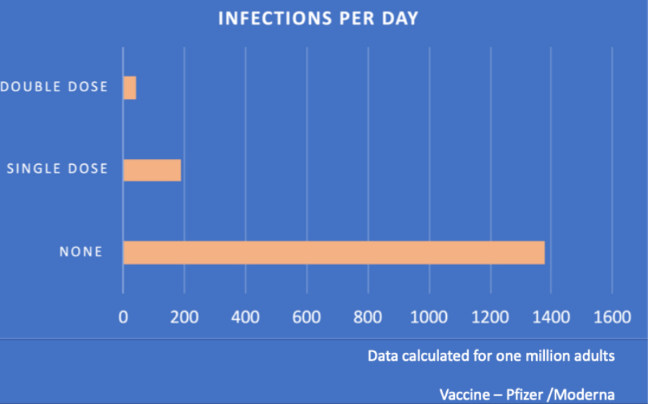
The Covid-19 pandemic is undoubtedly the worst health emergency in more than 100 years. The deadly new coronavirus has already killed more than 2.8 million people worldwide. The excellent emergency response by scientists, medical practitioners and various governments have resulted in the introduction of a large number of effective Covid-19 vaccines in less than one year.
Now the world is facing a second wave of the pandemic. There is an urgent need to cover a large part of the world population to stop the pandemic from spreading further. The Covid-19 vaccines cannot end the pandemic on their own. They need the acceptance of communities to receive them. This author has already written extensively on the deluge of information about the pandemic and the vaccines. This information overkill, called by some experts as infodemic, has led to unseen levels of vaccine hesitancy that may thwart the rollout plans of the national governments. The attack is mostly on the efficacy and effectiveness of the vaccines being administered after extensive trials.
READ I Step up Covid-19 vaccination drive to stop the second wave
Covid-19 vaccines: Efficacy vs effectiveness
As a student of clinical epidemiology, I was taught about the two poles of clinical trials, or randomised control trials (RCTs) — pragmatic versus explanatory clinical trials (or efficacy versus effectiveness trials). Explanatory trials are primed to maximise the likelihood of finding efficacy of an intervention by testing it in an ideal setting, whereas pragmatic trials test effectiveness of an intervention in a more generalisable setting.
Looks Like the United States Centers for Disease Control and Prevention (CDC) just gave the biggest endorsement yet for the Covid-19 vaccines. The earlier efficacy trials for Moderna and Pfizer vaccines showed that they are capable of preventing Covid-19 infections with efficacy in the 95% plus range. The CDC has just released the real-world data (pragmatic) from the US that is much more than you asked. A brilliant 90% success in the real-world scene, very close to that reported by the phase III results of both Moderna and Pfizer vaccines. What a triumph it is for evidence-based medicine.
The vaccine haters and doubters can rest their case now. Ever since the results of the efficacy trials were published, sceptics were suggesting that the real-world scenario could be lot different and there is a possibility that the two (Pfizer and Moderna vaccines) will fail. The CDC real world data states exactly the opposite. If at all there is a difference, it is too minimal and better ignored.
READ I India’s war on Covid-19 a success story of triple helix model
Covid-19 vaccines: CDC data spring a surprise

The CDC study enrolled 3,950 people at high risk of Covid-19 infection (healthcare workers, first responders and frontline workers). Among them, 2479 received two doses, 477 received just one dose and the remaining 994 were unvaccinated. None recruited had previously been infected with Covid-19. About 63% of participants received the Pfizer-BioNTech vaccine and 30 percent received the Moderna vaccine. The remaining 7% had other vaccines including the one from Johnson and Johnson.
All participants were asked to collect their own nasal swabs each week, which were sent for PCR testing, the best available diagnostic option for Covid-19 detection. The weekly swabs allowed the researchers to detect both asymptomatic infections as well as symptomatic infections.
And the results were stunning. There were 161 Covid infections in the unvaccinated workers, compared with 16 in those who had received only one dose and just three infections in people who had received both doses. The interpretation of these numbers tells us how good these shots are. Among those who were fully vaccinated (two doses at recommended intervals) there were .04 infections per 1,000 person-days. To put it in simple language, there would be just 0.04 infections in a day for a fully vaccinated group of 1000 people. Or like one infection per day for 25000 fully vaccinated people.
READ I Kerala economy: Time for soul searching on government size, welfare schemes
You might wonder how the single shots performed. They too did well with 0.19 infections per 1,000 person-days or like one infection per 5250 single shot people per day. Just compare these figures with 1.38 infections per 1,000 person-days in the case of unvaccinated people, or one infection per 725 unvaccinated people per day. Now you see the real beauty of these vaccines in a real-world scenario. It is nothing but a brilliant show in terms of prevention. The Pfizer vaccine had an efficacy of 95% in phase III trials while the moderna one had 94%.
The take home message from this pragmatic dataset is simple. Pfizer and Modern vaccines reduce the risk of covid infection by 80% with a single shot and by 90% with two shots in the real-world scenario. This is just for infections and the numbers for severe illness or death from covid is close to 100%. The two vaccines make it impossible to die from Covid-19. Science has triumphed once again through the golden route of evidence-based medicine.
While the data from real-world tests for the two vaccines being administered in India — Covaxin developed by Bharat Biotech and Covishield from AstraZeneca — are not available at the moment, there are reasons to believe that they too will closely match their respective efficacy reported from phase III trials.
(Dr Manu Raj is a paediatrician, clinical researcher and research methodologist based in Kochi. Views are personal.)
Dr Manu Raj is a paediatrician, clinical researcher and research methodologist based in Kochi.

